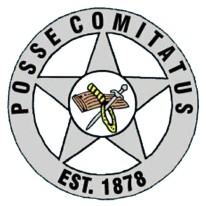
The Posse Comitatus Act of 1878 and Striking Workers
Curiously hidden within an otherwise banal defense appropriations bill, the Posse Comitatus Act of 1878 radically changed the role of the militia in the United States. It prevented the Army from enforcing federal law in the United States. This was later amended to include the Air Force, however, both the United States Marine Corps and the United States Navy are lacking from the law. The Navy has regulations which effectively provide the same prohibitions.
Also missing from the Act is anything preventing the state militias or the National Guard from enforcing relevant laws, provided that they are acting under the command of the governor and the state government. This meant that the state governments, acting largely under the control of the Democratic Party, could still use organized military – while the federal government, still dominated by Republicans, could not. While state militias were rarely, if ever, used in the same manner as the Klan and other white paramilitary organizations, the writing was on the wall – black citizens would no longer receive protection from the federal government against either the Democratic Party state governments or their more militant and rambunctious voters.
The Great Railroad Strike of 1877
 Militias under the control of the state largely acted not along racial lines, but economic ones. State militias were increasingly deployed against striking workers in labor disputes. The Great Railroad Strike of 1877, known contemporaneously as “the Great Upheaval,” is one such example. The first nationwide strike in American history, railroad workers went out on strike against a third wage cut in the span of a year. Over 100,000 workers walked off the job. Local and state militias played an instrumental role in breaking the strike, which lasted 45 days and left over 100 dead. Militia forces killed striking workers across the nation, including in Baltimore, Pittsburgh and Chicago.
Militias under the control of the state largely acted not along racial lines, but economic ones. State militias were increasingly deployed against striking workers in labor disputes. The Great Railroad Strike of 1877, known contemporaneously as “the Great Upheaval,” is one such example. The first nationwide strike in American history, railroad workers went out on strike against a third wage cut in the span of a year. Over 100,000 workers walked off the job. Local and state militias played an instrumental role in breaking the strike, which lasted 45 days and left over 100 dead. Militia forces killed striking workers across the nation, including in Baltimore, Pittsburgh and Chicago.
The Great Railroad Strike was not the last time that militias were used against striking workers. In Lemont, Illinois, two striking Polish quarry workers were killed by the militia. There was also a racial component to some strikebreaking. For example, in Thibodaux, Louisiana, the Louisiana Militia shot at least 35 unarmed striking black sugar workers.
The Ludlow Massacre of 1914
However, the most violent incident by far was the Ludlow Massacre of 1914. When the dust settled, 20 were dead – including 12 children and one bystander. As with many of the most pitched battles in American labor history, this involved the United Mine Workers. Mine work is dangerous everywhere, but this was particularly true out west. Workers were frequently paid in tonnage, and work that did not involve the digging of resources was unpaid. This meant workers often took chances with their lives, letting important repairs go undone and engaging in risky activities to get valuable minerals out of the ground.
Most of the striking workers in Ludlow, Colorado, had demands most Americans would sympathize with: Increased wages, payment for maintenance work, measures to keep weightmen honest, the right to live, shop and see a doctor at a place of their choosing, and the enforcement of existing state and federal laws.
The Massacre took place on Orthodox Easter, with the militia firing on striking worker camps with a machine gun. Women and children were attacked in an underground shelter with a fire set by the militia. While the United Mine Workers failed to obtain official recognition, the Massacre led to sweeping labor law reforms both in the United States and Canada. A monument erected by the United Mine Workers sits on the land once occupied by the striking workers’ tent camp.
The Militia Act of 1903 and the Modernization of the Militia
The Militia Act of 1903 was the most sweeping reorganization of the militia before the formation of the modern National Guard. Prior to the enactment of the Militia Act of 1903, the militias were governed both by the Constitution and the Militia Acts of 1792. The latter simply enabled the president to call out and command militias when appropriate and set the parameters for what constituted the militia. It left the question of state versus federal control of militias unresolved.
While the militia as a national defense had been problematic since the days of the War of 1812, the Spanish-American War demonstrated that the militia system in the United States was badly in need of reform from the standpoint of Federal control. The Militia Act of 1903 repealed the Militia Acts of 1792. It was this new Act which separated the militia, (unconstitutionally), into the organized and unorganized components. It also created the National Guard, an organization separate from both the organized militia and the National Guard of the United States, but with significant overlap with each. It has been argued that one of the issues driving the adoption of the Militia Act of 1903 was further disarmament of black Americans, particularly in the South during what is considered to be the nadir of race relations in the United States.
Left without much recourse in the way of self defense, the more militant members of the Civil Rights Movement began organizing what were effectively militias under the auspices of the National Rifle Association.
